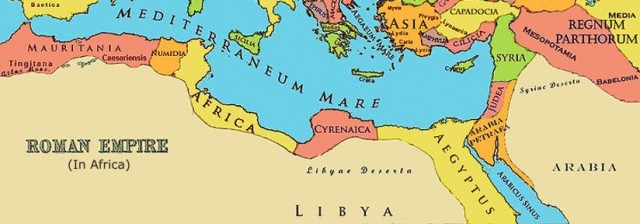Roman Africa
For centuries North Africa was part of the ancient Roman Empire, linked to Rome by conquest, colonization, and trade. Remains of Roman glory can still be seen at numerous archaeological sites from MAURITANIA in the west to EGYPT in the east.
Rome gained a foothold in Africa in 146 B.C., when it conquered the Phoenician colony of CARTHAGE in what is now TUNISIA. Eventually Carthage became the capital of the Roman province of Africa. West and south of Carthage lay Numidia, located in parts of present-day Algeria and Tunisia. Masinissa, a Numidian chieftain, had joined forces with Rome against Carthage in return for Roman recognition of his kingship. In 46 B.C. eastern Numidia became a Roman province called Africa Nova (“New Africa”). A separate province called Numidia was created later.

After Rome had acquired Carthage, Julius Caesar and his successor, Augustus, founded new settlements in Africa and extended Roman territory eastward to Cyrenaica (northeastern LIBYA). Roman forces also pushed south to the edge of the Sahara. In the A.D. 100s they constructed walls and ditches to mark the boundaries between Roman settlements and the nomadic peoples who roamed the desert and mountain regions to the south. By that time Egypt had also become Roman.
Augustus once boasted that “[he had] added Egypt to the empire of the Roman people.” In 31 B.C. his forces triumphed over those of his Roman rival Marc Antony and the Egyptian queen Cleopatra. Their defeat at the Battle of Actium paved the way for Augustus to claim Egypt as a Roman province. About 70 years later, Mauretania, west of Numidia, was divided into two Roman provinces. By that time, all of North Africa had been annexed by Rome.
Roman Africa played a significant role in the affairs of the Roman Empire. Egypt served as the launching point for military expeditions into Arabia. Many men born in the African provinces served in high positions in the imperial administration or in the Roman Senate. Septimius Severus, who became emperor of Rome in A.D. 193, came from a wealthy African family.
Africa's primary contribution to the empire, however, was food. Although Roman Africa engaged in trade and small-scale industries such as pottery-making, agriculture was the backbone of its economy. The region's principal exports were cereal grains and olive oil. As early as the first century A.D., Africa was supplying two-thirds of all grain consumed in the city of Rome. Much of the region's agricultural production came from farms owned by the thousands of retired Roman soldiers who had received land in the African provinces for their service to the empire.
A key feature of Roman Africa was the development of urban life. A few major cities, such as Carthage and ALEXANDRIA, existed before the Roman annexations. Rome established new cities and towns throughout the provinces, introducing urban culture to present-day ALGERIA and Tunisia. Wealthy citizens erected temples, theaters, and public baths in their African towns, just as wealthy people had done in Rome and in northern Roman provinces. Built of local marble and adorned with statues and colorful mosaic tiles, these structures are an enduring reminder of the time when North Africa belonged to Rome.
After the mid-400s, Roman control over the region weakened. When Arabs invaded the Roman provinces in the 600s, the struggling Byzantine Empire—all that remained of the former Roman Empire— offered little resistance. (See also Archaeology and Prehistory; Egypt, Ancient; North Africa: History and Cultures.)